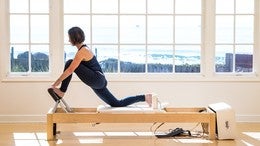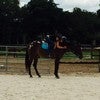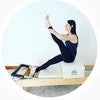Read Full Transcript
Hi, my name is Dana Santi. And today I'm going to kind of go through the second phase of a post surgery that I had in August of 2016. So we're going to stay in kind of the same family and we're just going to kind of add on the, um, expand the movement, maybe better said. So I'm going to start at the wall and I'm going to start with arm circles. So now I'm not changing the arm circle, I'm trying to keep everything all intact, but I know now that I can make the movement and I have to go SLU a little bit bigger and it goes up and maybe by the third or fourth one you can really get it up there.
And so now what I'm going to do is I'm going to reach up and all I want to do is see what it feels like if I can get all the back of my hand on the wall and just keep it attached. Because really this feels to me like I'm doing an enormous backbend and I'm not. So I'm going to enjoy every moment that I can. And then from here I'm going to reverse and I go up and then press down and again, and you reach, reach, reach, push the floor away from you one more time and then come down. And now I'm going to turn around and I'm gonna do some calf raises.
But this time making sure that my feet are nice and even, and I'm working the big toe. As much as I'm working the Pinky, I'm just going to add some knee bends and up and bend heels, push the floor away and then I can reverse it. Bend, get on all the toes, push the floor away and come down and bend and lift, push the floor away and come down. And now I'm going to take my forearms, place him up. And this time I'm going to bank on being able to get a little bit higher. But again, the important part is keeping the elbows straight down. So I take it as high as I can. Hold it there, hold it there, hold it there, make sure my hands are nice and even and then come back down and again and I'm going to go up and hold it there.
Big huge stretch in my upper back and my chest and one more time and I'm going elbows down, hold, kind of feels good and then come back home and now I'm going to walk away a bit, kind of in a safe place, feed our even and now I'm just going to try to walk up the wall to where I can and hold it there and then I'm going to walk back down again, half slide, half walk. [inaudible] and I get there and I hold it and come back. Anybody having a hard time connecting their arm to their back can benefit from all of this work. And again, the key is trying to keep that elbow down and not out to the side. The further the elbow goes out to the side, the more it's going to engage that peck and now I'm going to make a push up a little bigger. Okay. On all of my toes, not four of them, five of them.
And I'm just going to bend and push away keeping the elbows down and up and again and up. One more. And now I will continue on to the reformer. Okay. So now we're going to move on to reformer. And as I could safely say, I would be 12 weeks out of surgery. I am stronger, but don't let that get confused with being strong.
Okay? So I can do a lot of the exercises. Maybe I can't do as many reps, um, but I'm still trying to work what I did in the first workout, um, and just adapting it to these other exercises. So I'm going to start with the footwork like I would, and now I'm on four springs because my legs are stronger and I do the same thing though. I get all weird with my feet. So I just want them to be nice and even [inaudible] keeping the toes down and into the heels again, making sure there's that one straight line and then dropping down for 10 and stretch. And I'm going to push away and lower and lift.
And Lower and lift and again, and lift and lift and lift. Okay. I have four springs on and that may be too much. Um, for, you know, a normal client. I know my body well enough, I'm still, I'm going to try. Okay. Keeping it on Ford Springs. But remember that's just, it's, it's makes it a lot heavier so you have to make sure you're really engaged. And I'm going to press the arms down, reach the head and now maybe I can lift my legs.
Maybe I don't have to and inhale and exhale. But the key is not to have your arms come from behind you yet. And especially if you have this heavier spring on and I'm going to bend them right back in. And from here I can do the short spine because bringing the legs over your head, starting from this way is a lot easier than bending where they detach the muscle from and coming up. Yeah.
Okay. And just like I did in frogs and circles, I'm going to try to keep the foot nice or the strap nice and even in the foot. And I'm going to press it away and lift. And now I'm watching my knees and watching my feet to make sure I keep it in line and I bring it all the way over. And then Ben and now I'm going to roll down and I'm going to try to keep my knees straight. I don't want to open too much and then come back in and press and up and making everything work from the center and over and Ben [inaudible] and rural it away and bring it back in and push it away and up and Ben and roll it and come back. And now I may separate my legs just to see where my hips are and see what happens this way.
So I can tell which hip is better than the other hip and Ben and roll it and bring it in. Okay. So I've worked in many different places by now to get to rowing. And again, it's one of those things we think we need to do it right away because this muscle is so weak. But again, I'll go off and say that's not what we need. We need to work everything else in order to be able to support the work we're going to do on the arms. So now I'm in a row. I'm going to start with the arms out in front.
The range of motion is going to be small, very small. I'm going to take it though. Again, I'm going to watch my legs. Okay. Cause I can control that. I'm going to bring my arms out. So I'm trying to get my chest open, keeping my hand nice and even on the handle. And then I'm going to bring it back.
I'm going to keep trying to bring that chest open and bring it around and home and I roll back. So now I can kind of see with my legs that when I come back here I want to rotate my right leg out. Okay. And I got to keep it straight. So I'm gonna take that as my inner thigh is kind of detaching. Keep the legs straight, keep it straight. Keeping my arms straight open and home arm's long.
I'm at a bend a little bit wider than 90 and now I'm going to just try to keep them lifted and I know where my limit is cause I know how far I could crawl up that wall. Reach and again, reach on one more [inaudible]. Okay. Then I'm gonna turn row with my legs straight. [inaudible] can I try to keep the elbows in towards the body? Keep them straight down. [inaudible] elbows in and [inaudible] okay. Dropping the head stretch.
[inaudible] and again [inaudible] and one more [inaudible]. Okay. Shaving [inaudible] so I'm going to start wide. Okay. And I'm going to try to keep my elbows back behind me. ABS are lifted. Going to try to keep the shape that I have and come back. [inaudible] okay, then I'm going to give it the old college. Try [inaudible] one more.
[inaudible] okay. From here, your hug, keep him at arms long. [inaudible] and maybe I don't go as wide at the beginning. [inaudible] and one more. And if you think about it, the elbow still trying to reach down as I come in and reaching down and in. Okay, so now from here I'm going to do the long stretch series. Long box isn't good right now. The um, it still hurts too much to lay on your stomach and the, the tissue, um, it's all the nerves that are kind of dead and so there's still a little discomfort with that, but long stretch. So again, all I'm doing is I'm going to work on keeping the elbows down. So sometimes it depends too on the reformer, on the person, but maybe you want to do one spring instead of two springs and reach and come back in. I don't care how far out I go.
I care that my arms are in the right position. Down stretch. So same thing. Okay, I'm going to reach through my heels. Gonna keep the elbows where they are and just take a breath and again, and one more. Okay. Up Stretch. So up stretch is possible because I can control how far I go out, but there's a difference between the heel lifted and the heel flat.
The heel lifted kind of brings me closer towards my arms. Further away is not good. So push keeping the elbows where they should be. Okay. And as I do this, I'm going to try to keep the weight into my heels here and not bring it forward towards the ball of my foot. Okay. Elephant.
So all I've been doing is craving to do this exercise. Think I hated it my whole life and now all I want is it. So I can't because it still engages. It's still too, the distance is still too far away. So a lot of times I'll just sit here in the position and just hold it and try to lift the top of my foot up and I do it again. [inaudible] [inaudible] and if I want to then I come a little bit forward, get the heels down and keep it small. Work in the arms.
Okay. And then what I can do though, what's up? Keep the weight towards my heel a little and keep it small there. Okay. But the trick is to keep that weight in the back. Okay.
Now on to stomach massage. So I'm still keeping it on two springs because for me personally, I think I get the work that I need for it right now. But what I can do is I can put my arms in more positions and keep the same work going and if I kept the, if I put this spring higher like it should be, I would be, I would, I would have to work too hard in my lower body and too hard in my upper body. And what I want is to make the upper body stronger. Okay.
I'm going to do the same thing and just watch my feet and I'm going to reach my hands forward. Okay. And now I'm going to try to twist. I'm going to keep my hands together so then they don't go awry. They don't go to a place that I am unsure of yet. [inaudible] okay.
Now I'm on to tendon stretch so my arms don't veer too far from my body. I've been craving that stretch. Any stretch. [inaudible] so from here I'm gonna keep my arm straight. Elbows now are facing that back wall behind me and I'm going to just push out through the heels and then come back up, keeping the toes relaxed and down. [inaudible] now onto short box.
So again, I haven't dramatically changed any of this. I may try to put my arms back a little further, but um, if I do, it's not that it's necessary right now it's just me probably checking to see what the limits are in my, um, in my body. So I may [inaudible] so I am working on trying to keep this a little bit more open [inaudible] and twist [inaudible] and the same work that I did in the tree from before. [inaudible] trying to keep the hips even [inaudible] and as I can go all the way back, cause I did in the first part, I don't because I'm trying hard to figure out what I need to lengthen and what I need to pull back. So if I go too far away from it, then it kind of defeats the purpose for me. [inaudible] [inaudible] okay. Now from here [inaudible] I am going to do mermaid.
I can't do semi-circle cause the reach is too far away. Um, I've been craving a side stretch. So this has to go the movement, the movement of it is very small. But again, I know my body, I know what my limits are and I know when it's gone too far. So what I am gonna try to do is keep this elbow in.
Okay? So it's there and I'm not gonna let it veer too far away. So I'm going to push it away and I'm gonna use this to push and reach this arm over and then come back. I'm going to grab, I'm not going to balance anything and come up and I'm going to do it again because it feels good and I'm going to work the elbow down. [inaudible] and then I'm going to take it here and I'm going to push it away. Now I'm going to face it and I'm going to take the elbow and it goes a little, and then I'm going to push it away and a little down and push it away.
And a little down and push it away and then come back and switch sides. So again, working the elbow down, I'm going to keep it there. As I reach out in a way and come back. I'm going to grab, and again, keeping the elbow [inaudible] and then I'm here, I'm going to face it a bit and then the elbow down and push it away and bend the elbow down and push it away and bend the elbow down. Okay. And push it away and then come up.
Okay. I'm going to add a spring for my knee stretches. So again, my legs are stronger. Okay. It doesn't mean though that my chest is ready to lift. It doesn't mean that my chest is stronger, my legs are stronger, my chest is better. But again, it's not strong. So you kind of pick and choose your battles.
What's important right now? So I take one leg, still switch and then onto running. So I stay on two springs [inaudible] and it's not so much, um, leg strong or legs weak. I wanna do pelvic lift on to spring, so I'm just keeping it on too for running. And again, I still go wide because I'm still craving the stretch in the hips.
And then I finish again just like I did with the front stretch. Nothing different because again, no reason to and I don't want to fall. Okay. And just work in the hips, even get the stretch. Okay.
And now I will move on to some mat work. So now we're going to move on to the mat part and depending on how much reformer or how many reps I would have done, um, it, it may or may not be depending on your day wise to do both in the same day. Maybe you cut it down a little bit, maybe less reps if you feel like you need to do both. But by all means we really don't. So I will, I'm going to start with the a hundred and again, now my arms can go back a little bit more. Okay. And again, I go back to say this feels like a backbend. Okay. Arms Up, Chin in.
And now I'm still going to try to bend there and pumped and breathe. Okay. Keeping everything nice and straight. [inaudible] and then come back down. Okay. And now I'm in a roll up and I know my arms can come back a little further. [inaudible] and maybe by the fourth or fifth one I think I can get them back a little bit further.
[inaudible] so if I do, then when I go back like I would do on the wall, I'm just going to make sure that all parts of my hand are touching evenly [inaudible] and I feel for it [inaudible] and now as much as I want again to push my arms away from the polls, it's just too much. So I'm going to put my hands behind my head. Leg goes up, still working on getting my hips even and cross take a peek. [inaudible] and then I'm switch [inaudible] just trying to keep my knee straight. Working out of both sides of the leg, front side and back side. And now I'm a roll like a ball. So again, trying to keep my hips up [inaudible] and because my range of motion is a little different and more, I can do more of the stomach series. Not necessarily more reps, but more of them. The fourth and fifth one so I can reach away.
Okay. Ben is still work. The hips. Yeah, I can put the hands behind my head and Chris Cross. It's just slow going because that back elbow can be far away from that. Peck [inaudible] and now spine stretch forward, fingertips down [inaudible] and open leg rocker. So extend getting my hipbones up and [inaudible].
Yeah man corkscrew. So again, this is one you could leave out, you could do, you have to outweigh what it is that you need. Do you need it more or not? You can't push the poles away. You kind of have to keep it slow and steady because there's a lot of movement in there and your saw. So I know I can twist, I'm gonna try to keep the weight even on my hips.
I kind of know from when I did the tree, which one cooperates more than the other one. I'm ready for it. I'm going to try to keep the knees up towards the ceiling. [inaudible] and then I am going to do the neck pole. So this time I can keep my elbows wider cause I've been working on it. [inaudible] still watching the legs, make sure they're even weights even on both cheeks. [inaudible] and then spine twist.
[inaudible] okay. And now sidekicks, I can do sidekicks the way I did with the arm lifted. Um, I, I'm working a little bit on keeping that open so I can do more sidekicks maybe lifted, maybe I do less side kicks with the arm back this way. Okay. So you kind of have a choice. [inaudible] maybe I'd go up in small circles and then to the other side. [inaudible] trying to keep the tailbone nice and long just as if you were sitting [inaudible] an up and down [inaudible] in small circles.
Yeah. And if I stop after each one, it makes it a little harder. Okay. And then teaser. So like I did legs long, but now I know I can reach my arms back some. So I'm going to go for it and keep them there.
I keep my hips, even my legs even, and I reached my arms back. You can kind of see that the legs just lift themselves. Okay. And then the steel, so I'm going to clap. I'm going to keep my foot even right. So I pull the outside of the foot. Then I know my inner thighs are engaged.
[inaudible] and that is a wrap.















